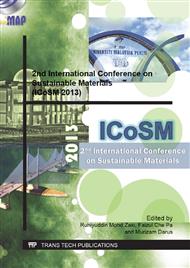[1]
C.W. Tang, S.A. VanSlyke, Organic electroluminescent diodes, Appl. Phys. Lett. 51 (1987) 913-915.
DOI: 10.1063/1.98799
Google Scholar
[2]
S. Sepeai, M.M. Salleh, M. Yahaya, A.A. Umar, Improvement of white organic light emitting diode performances by an annealing process, Thin Solid Films 517 (2009) 4679-4683.
DOI: 10.1016/j.tsf.2009.02.140
Google Scholar
[3]
J.C. Ribierre, C.J. Yates, A. Ruseckas, S.V. Staton, P.L. Burn, I.D.W. Samuel, Effects of solution processing and thermal annealing on the phosphorescence of iridium(III) complex-cored dendrimer films, Org. Electron. 11 (2010) 62-66.
DOI: 10.1016/j.orgel.2009.09.027
Google Scholar
[4]
M.-C. Sun, J.-H. Jou, W.-K. Weng, Y.-S. Huang, Enhancing the performance of organic light-emitting devices by selective thermal treatment, Thin Solid Films 491 (2005) 260-263.
DOI: 10.1016/j.tsf.2005.05.036
Google Scholar
[5]
K.A. Osipov, V.N. Pavlovskii, E.V. Lutsenko, A.L. Gurskii, G.P. Yablonskii, S. Hartmann, et al. Influence of thermal annealing on photoluminescence and structural properties of N,N'-diphenyl-N,N'-bis(1-naphthylphenyl)-1,1'-biphenyl-4,4'-diamine (a-NPD) organic thin films, Thin Solid Films 515 (2007) 4834-4837.
DOI: 10.1016/j.tsf.2006.11.029
Google Scholar
[6]
K.R. Choudhury, J. Lee, N. Chopra, A. Gupta, X. Jiang, F. Amy, F. So, Highly Efficient Hole Injection Using Polymeric Anode Materials for Small-Molecule Organic Light-Emitting Diodes, Adv. Funct. Mat. 19 (2009) 491-496.
DOI: 10.1002/adfm.200801368
Google Scholar
[7]
J.-H. Li, J. Huang, Y. Yang, Improved hole-injection contact for top-emitting polymeric diodes, Appl. Phys. Lett. 90 (2007) 173505-173503.
DOI: 10.1063/1.2731684
Google Scholar
[8]
M. Song, J. Park, M. Yoon, H. Yoon, A. Kim, S.-H. Jin, et al. Synthesis and characterization of poly(carbazolyl-2,7-vinylene) derivatives for organic light-emitting diode applications, Macromol. Res. 18 (2010) 1088-1095.
DOI: 10.1007/s13233-010-1111-y
Google Scholar
[9]
M.A. Mohd Sarjidan, S. H. Basri, W. H. Abd Majid,, Fabrication and Characterization of Organic Light-Emitting Diodes Containing Small Molecules Blends as Emissive Layer, Adv. Mat. Res. Accepted for publication (2012).
DOI: 10.4028/www.scientific.net/amr.795.106
Google Scholar
[10]
P.E. Burrows, V. Bulovic, S.R. Forrest, L.S. Sapochak, D.M. McCarty, M.E. Thompson, Reliability and degradation of organic light emitting devices, Appl. Phys. Lett. 65 (1994) 2922-2924.
DOI: 10.1063/1.112532
Google Scholar
[11]
Y.K. Fang, Y.T. Chiang, S.F. Chen, C.Y. Lin, S.C. Hou, C.S. Hung, et al. Observation of room temperature negative differential resistance (NDR) in organic light-emitting diode with inorganic dopant, J. Phys. Chem. Solids 69 (2008) 738-741.
DOI: 10.1016/j.jpcs.2007.07.067
Google Scholar
[12]
J.V. Foreman, H.O. Everitt, J. Yang, T. McNicholas, J. Liu, Effects of reabsorption and spatial trap distributions on the radiative quantum efficiencies of ZnO, Phys. Rev. B. 81 (2010) 115318.
DOI: 10.1103/physrevb.81.115318
Google Scholar
[13]
C. Adachi, T. Tsutsui, S. Saito, Blue light-emitting organic electroluminescent devices, Appl. Phys. Lett. 56 (1990) 799-801.
DOI: 10.1063/1.103177
Google Scholar


